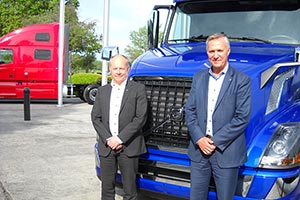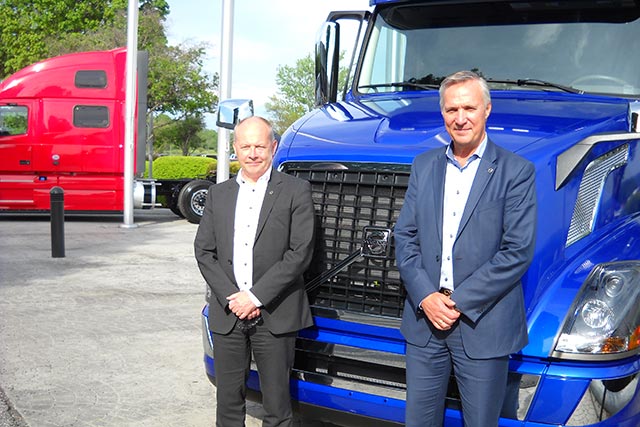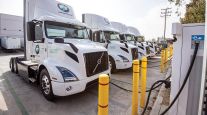Volvo Trucks Lobbying for Smooth Transition to Stricter Greenhouse-Gas Standards

 Claes Nilsson, Global President, Volvo Trucks (Left) Göran Nyberg, VTNA President (Right) Photo by Jonathan S. Reiskin/TT
Claes Nilsson, Global President, Volvo Trucks (Left) Göran Nyberg, VTNA President (Right) Photo by Jonathan S. Reiskin/TTDUBLIN, Va. — Volvo Trucks North America is laboring diligently to persuade federal and state regulators to ramp up standards on greenhouse-gas emissions in an orderly fashion so as not to scare off fleets from buying more fuel-efficient trucks that will be produced to comply with the Phase 2 rule expected later this year.
The company’s top executives told reporters and editors here May 11 that they are “doing a lot of lobbying to address the challenges and benefits” associated with the GHG proposal.
VTNA President Göran Nyberg said the lobbying is important because a mandate that is too aggressive could cause a pre-buy sales boom in 2019 and 2020 before Phase 2 takes effect, and then a sales bust in 2021 as fleets try to avoid the new anti-carbon dioxide controls.
“It’s nice to have a peak record for sales, but then it becomes very cold,” Nyberg said characterizing the problems with a boom-bust cycle.
In April in Austin, Texas, Mack Trucks global President Dennis Slagle — a colleague of Nyberg’s within Volvo Group — responded to a question and said Phase 2 is a matter of concern, but at the Volvo event here, Nyberg raised greenhouse gases as an issue near the beginning of his remarks.
Nyberg said VTNA takes greenhouse-gas emissions seriously and is eager to make more fuel-efficient trucks, as fleets always have an appetite for them, but the strategy should be to make vehicles that have market appeal so customers want to “get onboard early and not hold back” on adoption.
Phase 2 of greenhouse-gas regulations aimed at heavy- and medium-duty trucks came out as a joint proposal from the Environmental Protection Agency and the National Highway Traffic Safety Administration in June 2015.
Phase 2 will affect truck trailers made in 2018 and trucks in the 2021, 2024 and 2027 model years, requiring them to be more fuel-efficient as a means to emitting less carbon dioxide and other greenhouse gases.
Phase 1 started in January 2014, and the second and final segment of the first phase begins Jan. 1, 2017.
Nyberg also posed some challenges for government regulators, asking them to allow 6x2 powertrain configurations, particularly in Canada; eliminate the requirement for side mirrors; and speed up the adoption of platoon and autonomous trucks.




